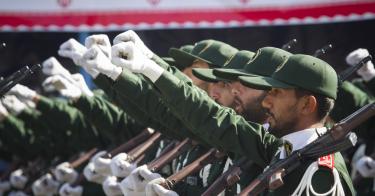President Donald Trump announced on Friday that the United States would not recertify the controversial Joint Comprehensive Plan of Action with Iran—commonly referred to as the “Iran nuclear deal.”
The controversial agreement has been under fire since President Barack Obama signed it in 2015. Critics have stated concerns that the deal did not do enough to prevent Iran from obtaining a nuclear weapon, something that threatens the security of the entire international community.
As Trump outlined in his strategy, Iran’s offences are not limited to its nuclear program. This is why he included countering Iranian aggression as one component of his four-point strategy.
Iran’s growing influence is a threat to regional stability and is harming U.S. allies. Since sanctions on Iran were lifted in 2016, Iran has enjoyed increased financial and economic influence, which it has since invested in destabilizing many of its neighbors.
In addition to having a nuclear program, here are four ways that Iran is increasingly destabilizing the Middle East.
1. Proxy wars and undermining of U.S. partners.
Iran has a long history of backing rebel groups and undermining established regional governments.
In Yemen, Iran is seeking to weaken Saudi Arabia’s influence by supporting the Houthi rebels against Saudi and Yemeni forces and against a Saudi-led Arab expeditionary force. The Houthis have carried out attacks on U.S. and U.S.-allied ships in the Red Sea with Iranian-supplied weapons.
Iran even threatened to take military action against Saudi Arabia.
2. Smuggling of weapons and soldiers.
Iran was able to capitalize on Iraq’s fight against ISIS and the instability that resulted. In particular, it has created transportation and logistical infrastructure to move soldiers and weapons through Iraq to its proxy forces in Syria and Lebanon.
Iran is doing the same in Yemen. One U.S. officer noted that Iran has provided Houthi fighters with a deadly arsenal of weaponry that has even been used to attack U.S.-allied ships in the Red Sea.
Iran has also recruited thousands of Afghan refugees and deployed them as armed volunteer forces to fight alongside President Bashar al-Assad’s troops in Syria.
3. Aligning with brutal regimes.
The Syrian civil war has been bloody and brutal. Over half a million Syrians have been killed, and millions more are now displaced. Iran’s support for Assad is one of the key elements safeguarding his government’s survival.
Iran has dispatched senior military figures, deployed hundreds of Revolutionary Guard soldiers, and provided monetary, intelligence, training, communications, and weapons support to Assad, despite his gross human rights violations.
Iran’s allies include hostile nations like Russia, which has fought alongside Iranian forces and Assad in Syria, as well as Venezuela, which is falling apart under a corrupt, anti-Western government.
Iran’s support of the Palestinian Authority has encouraged a rise in Palestinian terrorism and confidence in one day replacing Israel with a unitary Palestinian state.
4. State-sponsored terrorism.
One of Iran’s most notorious evils is its funding of terrorism. The State Department lists Iran as the No. 1 state sponsor of terrorism, and for good reason.
For years, Iran has backed anti-Western groups like Hamas and Hezbollah, as well as proxy groups in Iraq, Syria, and Yemen that have worsened ongoing regional conflicts.
In the Gaza Strip, Hamas regularly carries out attacks on Israel by using Iranian-funded weaponry, and having benefitted from Iranian-funded training.
In Lebanon, Hezbollah broadcasts pro-Iranian news and carries out attacks on the Lebanese-Israeli border. Iranian-backed Hezbollah fighters in Syria have played a role in propping up the Assad regime.
Iran has also been accused of supporting the Taliban in Afghanistan—a relationship the country formalized in early 2014—and of refusing to punish senior al-Qaeda members.
Preventing the Iranian regime from obtaining nuclear capabilities is important, but that is not the only threat Iran poses to the region.
Iranian influence is expanding, and instead of slowing or preventing this expanding influence, provisions under the Iran nuclear deal have made it easier for Iran to negatively influence and destabilize the Middle East.
Trump’s refusal to recertify the deal could mark a turning point in Iran’s destructive influence.
This piece originally appeared in The Daily Signal


